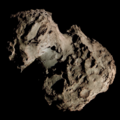 | |
| Discovery | |
|---|---|
| Discovered by | Michael Clark |
| Discovery date | June 9, 1973 |
| Designations | |
| 1973 V; 1978 XXIII; 1984 VIII; 1989 XX; 1994t | |
| Orbital characteristics | |
| Epoch | March 6, 2006 |
| Aphelion | 4.685 AU |
| Perihelion | 1.562 AU |
| Semi-major axis | 3.124 AU |
| Eccentricity | 0.4999 |
| Orbital period | 5.521 a |
| Inclination | 9.4883° |
| Last perihelion | 2023-Jan-21 [1] June 30, 2017 [2] December 15, 2011 |
| Next perihelion | 2028-Sep-28 [3] |
71P/Clark is a periodic comet in the Solar System with an orbital period of 5.5 years.
Contents
It was discovered by Michael Clark at Mount John University Observatory, New Zealand on 9 June 1973 with a brightness of apparent magnitude 13. Subsequently it has been observed in 1978, 1984, 1989, 1995, 2000, 2006, 2011 [4] and 2017. [5]
The nucleus of the comet has a radius of 0.68 ± 0.04 kilometers, assuming a geometric albedo of 0.04, based on observations by Hubble Space Telescope, [6] while observations by Keck indicate a radius of 1.305 km. [7]

